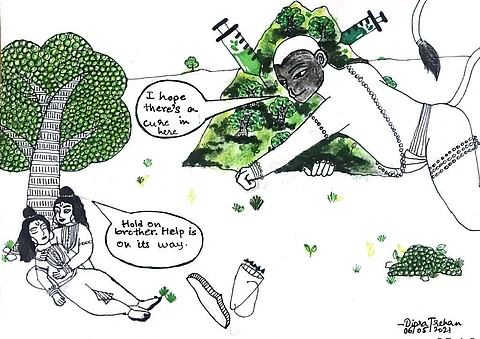

What can we do to make online classes more exciting?', is a question every teacher is asking themselves today. Because, let's admit it, online classes are no permanent substitute for the physical ones. High school English teacher from Sri Kumaran Children’s Home (CBSE campus at Mallasandra), Bengaluru, Lakshmy Ramanathan was pondering over the same among many other questions. "Right now, it's like a misfortune has befallen us. So I was wondering if the situation we are facing right now as humans, does that have a parallel in the past? At the same time, as an author, I have always wanted to write about the epics. You know, as they say, the Ramayana and the Mahabharata contain all the stories in the world. So soon, I was convinced that this is the way to interpret the epics — through the lens of the pandemic," she says. So the writer of For Bumpier Times (Hay House India, 2015) and After the Storm (Harper Collins, 2018) took to the pen in a way that is both familiar and new to her.
The idea was to take a few iconic scenes from the epics, turn them into a comic strip, ask questions that are fact-based, thought-provoking and COVID-based (colour-coded as white, orange and pink respectively) as well — linking it all to the epic. Not just this, the comics have been doodled by now 14-year-old Dipra Trehan, a former student of the teacher. These doodles depict one traditional art form of India, like Thanjavur, Madhubani and more. These scenes will be presented to students, starting next term, who will write the scene in reported speech, answer the questions and gain an understanding of art, epics, Coronavirus and so much more! Power-packed assignment, don't you think? Plus, it is completely in sync with the New Education Policy's (NEP) focus on art-integrated curriculum. Double whammy!
Now coming to the scenes themselves. Picture the scene from the Ramayana where Ravana has abducted Sita to Lanka. The doodle urges you to see this in the light of the lockdown. Sita, lonely and isolated with no freedom to move around. Sounds familiar? So, when she asks, "Sigh...When will this lockdown end?" Ravana thunders from his tower, "It is in your hands." Not only does the scene have motifs from Gond art, Dipra had the chance to add her own touch to what was unfolding. "In this scene, you will notice that the walls of the castle that Ravana is speaking from are old and crumbling," says the youngster. Come to think of it, it surely has a philosophical undertone since Ravana was killed at the end of the epic. And for all the detailing that did go into the doodle, you would think the student, who is soon going to Class XI, has doodled before, right? But it turns out this is her first time. She is an artist and has done paintings and drawings before, but this is the first time she took to doodling. "Though the brief of the scene came from Lakshmy ma'am, she gave me full room to implement and improvise as I deemed it fit. We also researched on which art form to depict were and it was a learning experience for me," says Dipra who dubs the teacher as the best.
READ ALSO: Amrita University launches certificate course on Mahabharata, six new online degrees
Talking about another scene, the 35-year-old teacher says, "We also took the scene where Lakshman draws the Lakshman Rekha outside Sita's hut before going into the forest. The parallel we draw here is by asking questions like, 'Can our exposure be reduced if we stay indoors?' which leads to one automatically thinking, how long can one stay in? What if we need to get essentials? This is directly linked to my students and my own daughter constantly asking me questions like, 'When will we get back to school?' or 'When will we see our friends?'. This scene makes them wonder about their own actions and if it's beneficial or detrimental in this ongoing pandemic," explains the teacher who was formerly a journalist and studied at Asian College of Journalism, Chennai.
"I have always longed to write about the epics. But the narratives around Sita and Draupadi have already been explored by famed writers like Chitra Banerjee Divakaruni. That's why, for this particular project, I thought that comics would be the best way to go because they are bite-sized and quicker to consume. Plus, I have always done something creative and extra for my class, in a way, it sustains me," says the Kochi-born teacher who was exposed to the epics through her grandfather's narration and books.
So, five scenes from the Ramayana will be given to students while five scenes from the Mahabharata are in the making. This will be given to students from classes IV and V, under the NEP guidelines for art integration, in August. And in this way, this assignment will teach students about grammar concepts like reported speech plus they'll learn about Indian art forms, epics and answer a range of questions too.
